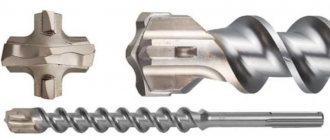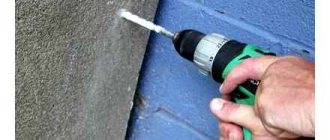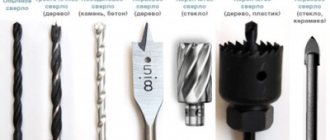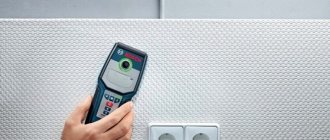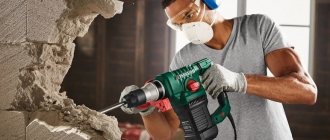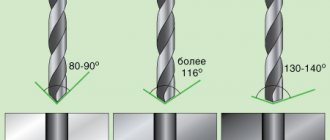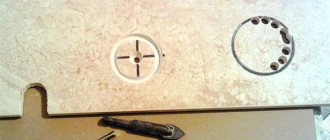A concrete drill is necessary when you need to make holes in a concrete wall or floor for fastening various objects or laying wiring. There are special requirements for such an instrument, because it must have sufficient power and resistance to mechanical abrasion. Only a high-quality device can drill through concrete without effort and risk of breakage.
Impact drill vs hammer drill
Both impact drills and rotary hammers are excellent for drilling into masonry. Although, of course, hammer drills are more powerful tools, and they have a special operating mode when only the surface is chiseled without drilling. They are usually equipped with an SDS cartridge, which copes better with the impact mode.
Of course, you can drill a couple of holes in a concrete wall with an ordinary drill using a masonry drill bit, but if you are faced with the task of making many holes in 50-year-old concrete, then you will probably want to find a more suitable one for yourself. convenient and effective equipment option. From this article you will learn all about the differences between an impact drill and a hammer drill and you will be able to understand which of these construction tools is right for you. We'll also introduce you to the most essential accessories and share some helpful tips on how to get the most out of these great tools.
All impact drills and rotary hammers are equipped with an impact function, which makes them extremely effective when working on masonry. In parallel with the rotation, both tools drive the drill into the surface of the masonry. These two instruments differ from each other in the mechanism that provides the percussion function.
In an impact drill, this mechanism consists of two toothed discs pressed against each other (see Figure A). When one disk, rotating, clings with its teeth to the teeth of the second disk, it then rises and then falls, as a result of which the cartridge produces an oscillatory (shock) movement. If there is no pressure on the chuck (when the drill is not pressed against the surface), the discs disengage and the impact mechanism stops. This prevents premature tool wear. Most impact drills can be used as a regular drill for drilling holes by simply turning off the impact function.
Figure A. Inside an impact drill: Impact is produced by two toothed discs.
In a hammer drill, the impact is achieved by a hammer piston driven by a crank shaft (see Figure B). The impactor piston performs translational and reciprocal movements in the cylinder and, when moving forward, creates air pressure, which activates the impact mechanism. Rotary hammers have much more impact power than impact drills. They are much more durable and are the main tool for professionals for this type of work. Another undoubted advantage is that most hammer drills can operate in three modes: drilling mode, impact-drilling mode and chiselling mode, so in some cases they can even be used as a jackhammer. Of course, they are more expensive than an impact drill, but we will return to this issue a little later.
Figure B: Inside a Hammer: A piston compresses air to produce a blow.
How much do impact construction tools weigh?
One cannot fail to note such an important distinguishing factor as the weight category of the instruments. The rotor is not only small in size, but also light in weight. This is due to the use of a low-power and high-speed electric motor capable of reaching speeds of up to 4000 rpm.
Rotary hammers are equipped with more powerful electric motors that develop low speed, but at the same time have high torque, which directly affects their weight category. Drilling devices are divided into three types by weight:
- Lightweight - up to 4 kg
- Medium - up to 6 kg
- Heavy - from 6 kg. These are barrel perforators, which, in addition to working mechanisms, have a special compartment for pouring liquid oil
The most powerful impact drill weighs no more than 4 kg. Light weight simplifies the operation of the tool, but not in all cases. When it is necessary to drill through concrete, the weight of the tool plays a big role. If, when drilling, the hammer needs to be pressed firmly against the surface of the material being processed, then the drill hammer does not need such actions.
Impact drill bits
Impact drills are ideal for light masonry work.
An impact drill works best for holes in brick, mortar, and concrete blocks. But it can also drill a couple of holes in poured concrete.
You don't necessarily have to spend a fortune on drill bits, but keep in mind that more expensive drill bits tend to be made from high-quality alloys and have tips that are more firmly attached to the shank, greatly reducing the risk of them breaking under heavy use.
What parameters are used to select tools?
Every craftsman must have an impact drill on his farm. It can not only drill metal and wood, but also concrete. If you plan to carry out repair and construction work, then it is recommended to purchase a hammer drill. Thanks to this specialized tool, you can perform various actions with durable materials - drill, drill, groove, etc.
When choosing percussion instruments, you need to take into account their following features:
- Power - the higher the indicator, the more efficient the tool. Only power directly affects the weight of the tool, so it is recommended to select tools based on power based on the complexity of the work.
- Design - hammer drills come in pistol and barrel types. The most popular are pistol hammer drills. They are lightweight and allow you to perform various manipulations with concrete. Barrel hammer drills belong to the category of heavy professional tools
- The presence of a reverse mode - this function is quite useful, as it allows you to rotate the tool chuck in both directions, which is very important when a drill or auger gets stuck in a hole
As for the cost and manufacturer, everything is simple here. If you need a reliable household assistant, then you should buy impact drills and hammer drills from well-known brand manufacturers. Such tools will never fail, and if they break down, you can always find spare parts. If the devices are used occasionally, then you should not choose the most expensive options.
Accessories for rotary hammers
Rotary hammers are designed for heavier construction work
Rotary hammers are excellent at drilling holes in hardened concrete.
They can also be equipped with various useful attachments.
The most popular type of chuck found on hardware store shelves today is the SDS-Plus chuck. SDS-Plus type drills have special grooves on the shank, due to which the drill is securely held in the chuck, but at the same time it can perform translational and reciprocating movements independently of the chuck. These drills are very easy to install and remove - no additional equipment is required. Some heavy-duty rotary hammer models use a similar clamping system, which differs only in its increased size - it is called SDS-Max. In addition, there are several brands that have developed their own clamping systems and corresponding drill bits, so when purchasing accessories, make sure that you buy an attachment that will fit your hammer drill.
A hammer drill operating in chiselling mode can be used to perform many types of repair and construction work, and in order to make this work easier for us, manufacturers have created a huge number of all kinds of attachments.
Possible equipment for the hammer drill includes various attachments for metal processing, chiselling, removing tiles, and even digging hard ground (in the picture on the left is a spade attachment for the SDS-Max chuck). In addition, you can attach a three-jaw chuck to the tool to use traditional drills.
Some of the most popular attachments are shown in the photo above:
- Earth Spade Attachment: Helps break up hard soil.
- Chisel for cold cutting: designed for chipping concrete.
- Tile Remover: Great for removing old ceramic tiles.
- Pointed chisel: This is useful for making pilot holes.
- Chisel: designed to remove rust, concrete deposits and splashes of molten metal.
If you already have a hammer drill and are looking to buy a powerful drill for drilling large holes, for example in wood, then we would recommend that you consider purchasing an SDS-Plus chuck adapter (shown in the photo below). This adapter will allow you to use cylindrical drill bits, hole saws and paddle mixers. The only thing is, do not forget to switch the hammer drill to drilling mode, otherwise the chuck may break.
Adapter for SDS-Plus socket. This adapter allows you to use your rotary hammer with cylindrical drills, hole saws and paddle mixers. Attention! When performing such work, the device must be in drilling mode, otherwise you will simply break the chuck.
What operating modes are present on the instruments?
The differentiating feature between an impact hammer and a hammer drill lies in the functionality of these tools. The design of hammer drills has three operating modes, due to which it is possible to process not only concrete. These modes have the following names and purposes:
- Drilling - the regulator must be turned towards the drill image. When this mode is enabled, the tool will operate in drilling mode. When this mode is turned on, the impact mechanism is turned off, and rotational energy from the electric motor shaft is supplied to the cartridge through a gear mechanism. In this mode, you can not only drill metal or wood, but also mix various building mixtures
- Rotation with impacts - the adjuster must be set towards the designation of the drill with a hammer. In this mode, the tool drills concrete, brick, reinforced concrete and stone materials. To implement these actions, you need to install a drill in the tool chuck
- Drilling - the control switches to the hammer designation. In this mode, the hammer drill is a jackhammer that can be used to remove tiles, drill concrete, brick, etc.
Unlike rotary hammers, percussion instruments have two operating modes. This is three times the difference between an impact drill and a hammer drill. The first mode of the tool is the main one - drilling. An electric drill is used to drill holes in metal, plastic, glass, and wood. If you need to get a hole in concrete, you need to turn on the impact drilling mode. Even if this function is available, it is not recommended to actively use the tool for drilling concrete.
This is interesting!
The
regulator
on drills is often located in the upper part of the tool near the chuck. On rotary hammers, the mode switching regulator is located on the side.
Choosing a suitable drill
Some drills will even drill through rebar. If you need to drill a hole in a reinforced concrete surface, do not skimp and buy a special drill designed for drilling concrete even through metal mesh and reinforcement bars.
For about $50 you can buy an impact drill that can drill shallow holes in most types of masonry, but by spending a little more on a hammer drill you will get two benefits in return: the ability to drill deep holes and, just as importantly, faster drilling speeds. which is especially important when you have to drill many holes at once.
The impact power of a drill is measured by BPM (blows per minute). But this is far from the only important indicator of the performance of an impact drill: much more important are the amperage of its motor and how conveniently this tool lies in your hands. All metal cartridges are more durable than cartridges with plastic parts. Quick-release chucks are undoubtedly more convenient for everyday work, but they are not well suited for drilling masonry, as they lack the holding force of the drill.
Selecting a drill class
When choosing a suitable device, you need to know what types of drills there are. The type of device depends on the purpose of use and the material to be processed.
Household
Household drills are suitable for home use. They can be rechargeable or powered by electricity. Household appliances have average power and are easy to operate. Even women can use the devices without damaging their manicure. Since the handles are comfortable, and the tool works at different speeds.
Professional
Professional devices are used in workshops or enterprises. They have high power and cope with materials of various densities. The advantage of the professional model is that you can use the drill for 8-9 hours without a break. Household devices are not intended for such purposes.
Professional models are often used in enterprises
Semi-professional
Ideal for home use. Suitable for cottages and garages. It has good engine power and is suitable for operating time up to 5-6 hours.
How to drill through a concrete wall with a regular drill?
The diameter of the chuck often determines the maximum recommended hole size that can be drilled with a particular drill.
The impact force of a hammer drill is measured in Joules. When choosing a hammer drill, remember that the more powerful the model, the better, but the force of its impact is even more important. Rotary hammers are classified by the maximum hole size they can drill according to the manufacturer's recommendations, but this does not mean that this tool is not capable of drilling a larger hole from time to time.
If you only need a drill to make couple-centimeter holes and nothing more, then buy a more powerful model so that it does not have to “puff” at maximum power all the time.
Is it possible to drill a hole in concrete with a screwdriver?
If there are no special tools at hand, then a screwdriver is used to drill concrete. However, attempts lead to the fact that it is not possible to achieve a positive result. This is due to the fact that the screwdriver does not have an impact drilling function, so it is contraindicated to use it for working with concrete. A screwdriver is designed to work with self-tapping screws, but it can also drill through wood. Just keep in mind that screwdrivers are based on a low-power electric motor. If the motor experiences maximum load, it may simply burn out.
If you are going to drill through thick wood with a screwdriver with a 10 mm drill bit, then immediately abandon this idea. You should especially not use the tool for drilling concrete or mixing the mixture. It will not be possible to drill concrete with a screwdriver, since this device does not have an impact mode. It is also not recommended to mix bulk mixtures with a mixer attachment in the chuck. The engine will experience high loads (and it has very little torque), and therefore can burn out very quickly.
This is interesting!
Each tool has its own purpose, so before using one or another device, you should read the instructions.
Secrets of mastery
- Clear Debris
The grooves on the drill bit are designed to remove debris from the hole as you drill, but to keep the hole as clean as possible, simply remove the drill bit from time to time as you work. This simple technique will help reduce friction, as a result of which the drilling process will proceed more smoothly, the drills will not get stuck, and they will last longer this way. - Know how to stop in time
Most impact drills and rotary hammers are sold complete with a side handle and a drilling depth limiter. Don't be lazy to use them! You should not drill holes deeper than you need, and thereby “kill” both your time and the drills. And it’s not always necessary to make a through hole: for example, some plastic anchors must be installed in a concrete block with a stop, otherwise they may simply fall out on the other side of the through hole. - Do not press too hard
When drilling, it is important to grasp the optimal ratio of drilling speed and pressure on your part, at which the drill begins to work in the fastest possible mode. But you are unlikely to achieve this if you press the drill with all your might. The fact is that too much pressure will, on the contrary, slow down the drilling process and lead to premature wear of the tool motor. In addition, in the process of such rough operation you risk breaking all your expensive drills. - Start with a small hole
If you need to drill several holes that will be larger in diameter than the maximum recommended by your drill manufacturer, make a smaller hole first. This will significantly reduce the load on the drill. In addition, smaller drills do not glide across the surface as much as larger ones, which means this advice will definitely come in handy in a situation where you need to drill a hole in a precise location.
Choosing a tool and working with it
When choosing a tool to drill a hole, you should understand that your work depends on it. A good drill accurately drills into a concrete wall or other required material, simplifying the drilling process, while a bad one will require a lot of time, may not cope with the task, or will complicate it. What you need to pay attention to when choosing a drill:
- Is it possible to change the drilling speed? – this point is important, since correction of the speed mode will ensure accurate operation of the drill, helping it not to damage the surface.
- Is it possible to hammer drill and adjust the depth? – impact drilling can be used on problem areas, softening them.
- Is it possible to hold the drill with both hands? – a drill is not a light tool and therefore preference should be given to models that are equipped with handles.
- Is the tool's power sufficient for your job?
Having decided on a drill, before starting work you need to get the hang of holding it. To do this, you should take the drill in one hand, like a pistol, and place the other hand on the handle of the tool (if it is not intended by the design, the hand is placed near the chuck). It is necessary to hold the drill in your hands strictly horizontally, so that the hole does not turn out distorted or at the wrong angle. Wait until the drill reaches ambient temperature before turning on the drill. Sudden temperature changes can cause condensation. If you decide to rest while working, unplug the tool.
Return to contents
What else to consider when choosing a drill
When choosing a device, in addition to the basic characteristics, it is necessary to take into account additional ones. These include:
- fixing the power button. This characteristic allows you to ensure safe operation of the device;
- Auto shut-off function. The presence of this function prevents the drill from burning out during prolonged use. If the device gets hot, it automatically turns off;
- backlight Allows you to make a hole accurately, even in a dark room;
- dust collector Makes it easier to clean the room later.
Also, additional criteria include the presence of attachments. A second handle will not be superfluous, with the help of which it will be convenient to work in hard-to-reach places.
Additional features make the tool convenient to use

